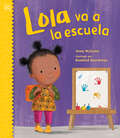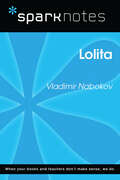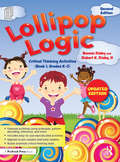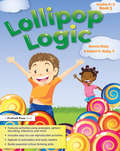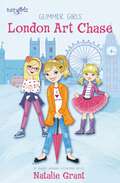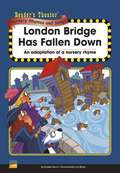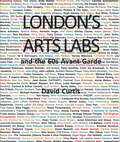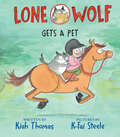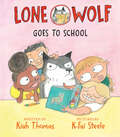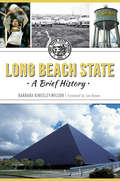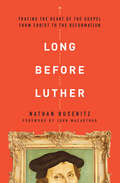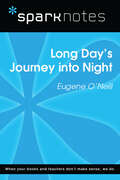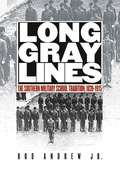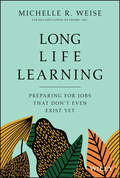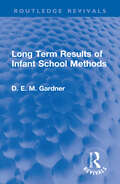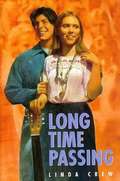- Table View
- List View
Lola va a la escuela (LOLA READS)
by Anna McQuinn¡Ahora disponible en español! Lola se prepara para una nueva y emocionante aventura: ¡su primer día de escuela!Una lectura alegre y alentadora que deja de lado todo mito sobre el preescolar y el jardín de infantes. Desde la noche anterior, Lola y su familia se preparan para el primer día de escuela. Al día siguiente se levantan temprano, se toman fotos y salen para la escuela. Allí, Lola pone sus cosas en un lugar especial, escoge actividades para hacer, lee, juega y toma la merienda. Sin darse cuenta, ya es hora de cantar la canción de despedida y de ir corriendo a los brazos de mamá, que la espera con mucho cariño. *Now in Spanish--Lola is excited to embark on a new adventure, her first day of school!*A comforting, cheerful read that demystifies the school day for preschoolers and kindergarteners. Lola and her family prepare for the first day of school the night before, then get up early, take pictures, and head to class. Lola puts her things in her cubby, chooses her activities, reads, plays, and has a snack. Before she knows it, it's time to sing the good-bye song and rush into Mommy's arms for a warm reunion.
Lolita (SparkNotes Literature Guide Series)
by SparkNotesLolita (SparkNotes Literature Guide) by Vladimir Nabokov Making the reading experience fun! Created by Harvard students for students everywhere, SparkNotes is a new breed of study guide: smarter, better, faster. Geared to what today's students need to know, SparkNotes provides: *Chapter-by-chapter analysis *Explanations of key themes, motifs, and symbols *A review quiz and essay topicsLively and accessible, these guides are perfect for late-night studying and writing papers
Lollipop Logic: Critical Thinking Activities (Book 1, Grades K-2)
by Bonnie L. Risby Robert Risby IIWhat a tantalizing treat for young minds! Seven different thinking skills—relationships, analogies, sequences, deduction, inference, pattern decoding, and critical analysis—are presented in a format designed to appeal to the prereader. Lollipop Logic employs visual and pictorial clues to introduce and reinforce high-powered thinking. This one-of-kind tool gives wings to prereaders and nonreaders. This unique book introduces complex thinking skills without the fetters of lexical meaning. Lollipop Logic is the perfect instrument for many young learners. It is simple to use and easy for youngsters to understand. Best of all, it alleviates the encumbrances of reading ability for young minds ready to soar into the stratosphere of thinking skills far beyond their reading levels.For more advanced logic activities, refer to Logic Countdown, Logic Liftoff, Orbiting with Logic, and Logic Safari Books 1, 2, and 3.Grades K-2
Lollipop Logic: Critical Thinking Activities (Book 1, Grades K-2)
by Bonnie Risby Robert K. Risby, IILollipop Logic employs visual and pictorial clues to introduce and reinforce high- powered thinking for pre- readers. Seven different thinking skills—relationships, analogies, sequences, deduction, inference, pattern decoding, and critical analysis—are presented in a format designed to appeal to gifted young learners. This straightforward, one-of-a-kind tool gives wings to pre-readers and non-readers who are ready for a challenge but don’t yet have the reading skills for more traditional critical thinking activities. Now with full-color illustrations, this beloved classic has been fully updated with refreshed activities, images, and text to help young learners continue to soar into the stratosphere of thinking skills far beyond their reading levels.
Lollipop Logic: Critical Thinking Activities (Book 2, Grades K-2)
by Bonnie L. Risby Robert Risby IIWhat a tantalizing treat for young minds! Different thinking skills—relationships, analogies, sequences, deduction, inference, pattern decoding, and critical analysis—are presented in a format designed to appeal to the prereader. Visual and pictorial clues are used to introduce and reinforce high-powered thinking. Unfettered by their lack of reading ability, young minds experience exciting forays into critical thinking skills. With the new Lollipop Logic Book 2, prereaders, along with readers of all skill levels, can embark on an adventure of high-powered thinking using visual and pictorial clues. Each reproducible provides motivating exercises in a user-friendly format. Now, even very young children can cultivate critical thinking skills.
Lollipop Logic: Critical Thinking Activities (Book 2, Grades K-2)
by Bonnie Risby Robert K. Risby, IILollipop Logic employs visual and pictorial clues to introduce and reinforce high-powered thinking for pre-readers. Seven different thinking skills—sequences, relationships, analogies, deduction, pattern decoding, inference, and critical analysis—are presented in a format designed to appeal to gifted young learners. This straightforward, one-of-a-kind tool gives wings to pre-readers and non-readers who are ready for a challenge but don’t yet have the reading skills for more traditional critical thinking activities. Now with full-color illustrations, this beloved classic has been fully updated with refreshed activities, images, and text to help young learners continue to soar into the stratosphere of thinking skills far beyond their reading levels.
Lollipop Logic: Critical Thinking Activities (Book 3, Grades K-2)
by Bonnie L. Risby Robert Risby IISeven different thinking skills—relationships, analogies, sequences, deduction, inference, pattern decoding, and critical analysis—are presented in a format designed to appeal to the prereader. Lollipop Logic Book 3 employs visual and pictorial clues to introduce and reinforce high-powered thinking. This one-of-a-kind tool gives wings to prereaders and nonreaders. Best of all, it enables young minds to soar into the stratosphere of thinking skills far beyond their reading levels.Grades K-2
Lollipop Logic: Critical Thinking Activities (Book 3, Grades K-2)
by Bonnie Risby Robert K. Risby, IILollipop Logic employs visual and pictorial clues to introduce and reinforce high-powered thinking for pre-readers. Seven different thinking skills—sequences, relationships, analogies, deduction, pattern decoding, inference, and critical analysis—are presented in a format designed to appeal to gifted young learners. This straightforward, one-of-a-kind tool gives wings to pre-readers and non-readers who are ready for a challenge but don’t yet have the reading skills for more traditional critical thinking activities. Now with full-color illustrations, this beloved classic has been fully updated with refreshed activities, images, and text to help young learners continue to soar into the stratosphere of thinking skills far beyond their reading levels.
Lollipop Logic: Critical Thinking Activities (Book 4, Grades K-2)
by Bonnie Risby Robert K. Risby, IILollipop Logic employs visual and pictorial clues to introduce and reinforce high-powered thinking for pre-readers.Seven different thinking skills—sequences, relationships, analogies, deduction, pattern decoding, inference, and critical analysis—are presented in a format designed to appeal to gifted young learners. This straightforward, one-of-a-kind tool gives wings to pre-readers and non-readers who are ready for a challenge but don’t yet have the reading skills for more traditional critical thinking activities. With full-color illustrations, this new addition to the beloved series has even more activities, images, and text to help young learners soar into the stratosphere of thinking skills far beyond their reading levels.
London Art Chase (Faithgirlz / Glimmer Girls)
by Natalie GrantIn London Art Chase, the first title in the new Faithgirlz Glimmer Girls series, readers meet 10-year-old twins Mia and Maddie and their adorable little sister, LuLu. All the girls are smart, sassy, and unique in their own way, each with a special little something that adds to great family adventures.There is pure excitement in the family as the group heads to London for the first time to watch mom, famous singer Gloria Glimmer, perform. But on a day trip to the National Gallery, Maddie witnesses what she believes to be an art theft and takes her sisters and their beloved and wacky nanny Miss Julia, on a wild and crazy adventure as they follow the supposed thief to his lair. Will the Glimmer Girls save the day? And will Maddie find what makes her shine?
London Bridge Has Fallen Down: An Adaptation of a Nursery Rhyme
by Jeffrey B. Fuerst Lyn Boyer Brooke HarrisThe old bridge fell down. What will the people of London do?
London's Arts Labs and the 60s Avant-Garde
by David CurtisThis is the story of two short-lived artist-run spaces that are associated with some of the most innovative developments in the arts in Britain in the late 1960s. The Drury Lane Arts Lab (1967–69) was home to the first UK screenings of Andy Warhol's twin-screen 3 hour film Chelsea Girls, challenging exhibitions (John and Yoko / John Latham / Takis / Roelof Louw), poetry and music (first UK performance of Erik Satie's 24-hour Vexations) and fringe theatre (People Show / Freehold / Jane Arden's Vagina Rex and the Gas Oven / Will Spoor Mime Theatre). The Robert Street 'New Arts Lab' (1969–71) housed Britain's first video workshop TVX, the London Filmmakers Co-op's first workshop and a 5-days-a-week cinema devoted to showing new work by moving-image artists (David Larcher / Malcolm Le Grice / Sally Potter / Carolee Schneemann / Peter Gidal). It staged J G Ballard's infamous Crashed Cars exhibition and John & Dianne Lifton's pioneering computer-aided dance/mime performances.The impact of London's Labs led to an explosion of new artist-led spaces across Britain. This book relates the struggles of FACOP (Friends of the Arts Council Operative) to make the case for these new kinds of space and these new art-forms and the Arts Council's hesitant response – in the context of a popular press already hostile to youth culture, experimental art and the 'underground'. With a Foreword by Andrew Wilson, Curator Modern & Contemporary British Art and Archives, Tate Gallery.
Lone Wolf Gets a Pet (Lone Wolf)
by Kiah ThomasOscar the Grouch meets Frog & Toad in this hilarious illustrated early reader series about a cranky wolf on a quest to be left alone.Wolf lives by himself, and he likes it that way. Wolf is not a people person. But today, he would really like some jellybeans, and the store is completely out. The shopkeeper tells him that all the jellybeans have been bought up for prizes in a competition. A Best Pet Competition.There&’s only one thing for it: Wolf needs to acquire a darling dog, a cool cat, or a happy horse. But one by one, these animals prove that Wolf is not much of an animal person, either. Will no pet win him an award? How far must Wolf go to get some dang jellybeans?Move over, Elephant & Piggie! For readers who have had enough of the buddy duos, for kids who&’d rather play by themselves—Wolf is the antihero you&’ve been waiting for. Lone Wolf Gets a Pet is the second in a hilarious early reader series starring the completely lovable, chronically grumpy Wolf, a character who affirms kids who fly solo better than with friends.Kids who are beginning to read on their own won&’t be able to get enough of Kiah Thomas&’s sarcastic stories, perfect whether read alone or out loud, and K-Fai Steele&’s laugh-out-loud illustrations will give any kid, no matter their reading level, a new favorite series.A Junior Library Guild Gold Standard Selection
Lone Wolf Goes to School (Lone Wolf)
by Kiah ThomasOscar the Grouch meets Frog & Toad in this hilarious illustrated early reader series about a cranky wolf on a quest to be left alone.Wolf has just the right amount of friends: NONE. He loves to be alone. Unfortunately, everywhere he goes, other people are there too. At school, the teacher says if he can&’t get along with the other students, he has to leave. So he goes to the movies. More people! He tries the beach. No peace there, either. He flees to the remote peak of a mountain, and even there, someone comes along to bother him. Finally, Wolf hatches a plan. All these people arrive for a party at Wolf&’s house . . . while Wolf makes a quick exit.Move over, Elephant & Piggie! For readers who have had enough of the buddy duos, for kids who&’d rather play by themselves—Wolf is the antihero you&’ve been waiting for. Lone Wolf Goes to School is the first in a hilarious early reader series starring the completely lovable, chronically grumpy Wolf, a character who affirms kids who fly solo better than with friends.Kids who are beginning to read on their own won&’t be able to get enough of Kiah Thomas&’s sarcastic stories, perfect whether read alone or out loud, and K-Fai Steele&’s laugh-out-loud illustrations will give any kid, no matter their reading level, a new favorite series.A Junior Library Guild Gold Standard Selection
Lonely Children and Adolescents
by Malka MargalitFrom texting and social networking sites to after-school activities, young people have many opportunities to interact with one another, and yet loneliness and isolation trouble today's youth in increasing numbers. Many children and teens report feeling lonely even in the midst of family and friends, and childhood loneliness is a prime risk factor for adult alienation. Lonely Children and Adolescents: Self-Perceptions, Social Exclusion, and Hope illuminates seldom-explored experiences of social isolation among young people as well as the frustrations of the parents and teachers who wish to help. This groundbreaking book conceptualizes loneliness not simply as the absence of social connections, but as a continuum of developmental experience, often growing out of the conflict between opposite needs: to be like one's peers yet be one's unique self. The author draws clear distinctions between loneliness and solitude and identifies genetic and environmental characteristics (i.e., social, psychological, familial, and educational) that can be reinforced to help children become more resilient and less isolated. In addition, therapeutic approaches are described that challenge loneliness by encouraging empowerment, resilience, and hope, from proven strategies to promising tech-based interventions. Highlights include: * Developmental perspectives on loneliness. * Schools and the role of teachers, from preschool to high school. * Peer relations (e.g., cliques, bullies, exclusion, and popularity). * Lonely children, lonely parents: models of coping. * Loneliness in the virtual world. * Prevention and intervention strategies at home, at school, in therapy. Asking its readers to rethink many of their assumptions about social competence and isolation, this volume is essential reading for researchers and professionals in clinical child, school, developmental, and educational psychology; allied education disciplines; social work; and social and personality psychology.
Long Beach State: A Brief History (Brief History)
by Barbara Kingsley-Wilson Lee BrownLong Beach State grew up right along with the sprawling Southern California suburbs. Born in 1949, it swelled to accommodate the post-world war enthusiasm for education and land. The rapid expansion brought its share of growing pains. Students took classes in a cramped converted apartment with no books and playing ring-around-the-rosie for physical education. Money was scarce, and faculty at times feuded with the administration. But the new college's "let's put on a show" spirit produced a scrappiness that endures today. Read about the personalities that grew the college from Fred Bixby's bean fields into one of the largest universities in California.
Long Before Luther: Tracing the Heart of the Gospel From Christ to the Reformation
by Nathan BusenitzWhere was the gospel before the Reformation?Contemporary evangelicals often struggle to answer that question. As a result, many Roman Catholics are quick to allege that the Reformation understanding of the gospel simply did not exist before the 1500s. They assert that key Reformation doctrines, like sola fide, were nonexistent in the first fifteen centuries of church history. Rather, they were invented by Martin Luther, John Calvin, and others.That is a serious charge, and one that evangelicals must be ready to answer. If an evangelical understanding of the gospel is only 500 years old, we are in major trouble. However, if it can be demonstrated that Reformers were not inventing something new, but instead were recovering something old, then key tenets of the Protestant faith are greatly affirmed. Hence, the need for this book.After reading Long Before Luther, readers will: Possess a greater understanding of church history and the role it plays in the church today.Have a deeper appreciation for the hard-won victories of the Reformation.Be equipped to dialogue with Catholic friends about the presence of Reformed doctrines throughout church history.Feel renewed gratefulness for the unearned nature of grace and the power of the gospel.
Long Before Luther: Tracing the Heart of the Gospel From Christ to the Reformation
by Nathan BusenitzWhere was the gospel before the Reformation?Contemporary evangelicals often struggle to answer that question. As a result, many Roman Catholics are quick to allege that the Reformation understanding of the gospel simply did not exist before the 1500s. They assert that key Reformation doctrines, like sola fide, were nonexistent in the first fifteen centuries of church history. Rather, they were invented by Martin Luther, John Calvin, and others.That is a serious charge, and one that evangelicals must be ready to answer. If an evangelical understanding of the gospel is only 500 years old, we are in major trouble. However, if it can be demonstrated that Reformers were not inventing something new, but instead were recovering something old, then key tenets of the Protestant faith are greatly affirmed. Hence, the need for this book.After reading Long Before Luther, readers will: Possess a greater understanding of church history and the role it plays in the church today.Have a deeper appreciation for the hard-won victories of the Reformation.Be equipped to dialogue with Catholic friends about the presence of Reformed doctrines throughout church history.Feel renewed gratefulness for the unearned nature of grace and the power of the gospel.
Long Day's Journey Into Night (SparkNotes Literature Guide Series)
by SparkNotesLong Day's Journey Into Night (SparkNotes Literature Guide) by Eugene O'Neill Making the reading experience fun! Created by Harvard students for students everywhere, SparkNotes is a new breed of study guide: smarter, better, faster. Geared to what today's students need to know, SparkNotes provides: *Chapter-by-chapter analysis *Explanations of key themes, motifs, and symbols *A review quiz and essay topicsLively and accessible, these guides are perfect for late-night studying and writing papers
Long Gray Lines
by Rod AndrewMilitary training was a prominent feature of higher education across the nineteenth-century South. Virginia Military Institute and the Citadel, as well as land-grant schools such as Texas A&M, Auburn, and Clemson, organized themselves on a military basis, requiring their male students to wear uniforms, join a corps of cadets, and subject themselves to constant military discipline. Several southern black colleges also adopted a military approach. Challenging assumptions about a distinctive "southern military tradition," Rod Andrew demonstrates that southern military schools were less concerned with preparing young men for actual combat than with instilling in their students broader values of honor, patriotism, civic duty, and virtue. Southerners had a remarkable tendency to reconcile militarism with republicanism, Andrew says, and following the Civil War, the Lost Cause legend further strengthened the link in southerners' minds between military and civic virtue. Though traditionally black colleges faced struggles that white schools did not, notes Andrew, they were motivated by the same conviction that powered white military schools--the belief that a good soldier was by definition a good citizen. "[Long Gray Lines] is a valuable resource. It is well researched, well argued and thought provoking. . . . A useful work with important insights into a significant southern tradition.--Civil War Book Review"An important work that engages larger historical questions.--Journal of Military History "This provocative, highly original, and thoughtfully illustrated study is grounded in impressive research. . . . It invites us to rethink the southern military tradition.--Journal of Southern HistoryChallenging assumptions about a distinctive "southern military tradition," Rod Andrew demonstrates that southern military schools were less concerned with preparing young men for actual combat than with instilling in their students broader values of honor, patriotism, civic duty, and virtue. Southerners had a remarkable tendency to reconcile militarism with republicanism, Andrew says, and following the Civil War, the Lost Cause legend further strengthened the link in southerners' minds between military and civic virtue. -->
Long Life Learning: Preparing for Jobs that Don't Even Exist Yet
by Michelle R. WeiseLong Life Learning offers readers a fascinating glimpse into a future where the average working life has no beginning, middle, or end. Contemplating a shift from the educational all-you-can-eat buffet of college and university to an "as-you-need-it" approach to delivering education, author Michelle Weise explains why and how worker education is overdue for momentous changes. Written in two parts, Long Life Learning begins by imagining a world where increased lifespans have contributed to creating working lives that span over 100 years. The book asks the question that naturally arises as a result: Will a four-year education taken at the beginning of a 100-year career adequately prepare a worker for their entire working life? After providing readers a thorough explanation of why our current education system is poorly equipped to educate workers for such a long journey, Weise outlines the solutions to the shortcomings of the existing framework. From wraparound supports for workers to targeted education, integrated earning and learning, and transparent and fair hiring, Long Life Learning describes exactly how the existing education system must adapt in order to meet the needs of a new generation of workers. The book makes a compelling case for the coming need for ongoing, periodic education, as well as training that is seamlessly integrated into our future jobs. Perfect for workers, young and old, and the educators and employers preparing talent as the ground shifts underneath their feet, Long Life Learning belongs on the bookshelves of anyone with an interest in the future of work, education, and the labor market.
Long Term Results of Infant School Methods (Routledge Revivals)
by D.E.M. GardnerFirst published in 1950, Long Term Results of Infant School Methods was written to explain and summarise the results of Gardner’s experiment to test the extent to which the effect of different styles of Infant school education, "experimental" or "control", would also be apparent at a later stage. The book details how the tests and the schools involved were chosen; the different types of tests conducted and their respective aims; and a summary of Gardner’s conclusions. It will appeal to those with an interest in the history and theory of education.
Long Time Passing
by Linda CrewIn her sophomore year of high school Kathy Shay begins the process of coming of age in a small town in Oregon during the turbulent 1960s.
Long, Tall Lincoln (I Can Read Level 2)
by Jennifer DusslingAbraham Lincoln didn’t look like a president. He didn’t always act like a president, either—he liked to wrestle with his sons and tell jokes. But he always fought for fairness, freedom, and unity.Beginning readers will learn about the milestones in Abraham Lincoln’s life in this Level Two I Can Read biography, which combines a traditional, illustrated narrative with historical photographs at the back of book. Complete with a timeline, photographs, and little-known facts about the United States’ sixteenth president: the long and tall Abraham Lincoln.Long, Tall Lincoln is a Level Two I Can Read, geared for kids who read on their own but still need a little help.
Long-Term Memory Problems in Children and Adolescents
by Milton J. Dehn"This book will be a valuable resource for psychologists and educators who work with children or adolescents who are having difficulties with memory and learning. Translating theory and research into practice is a talent that Dr. Dehn possesses and we will benefit from his professional skills."-- From the Foreword by Daniel C. Miller, PhD, ABPP, ABSNP, NCSPAn indispensable guide that examines the effect of long-term memory functions on children's learningLong-Term Memory Problems in Children and Adolescents: Assessment, Intervention, and Effective Instruction is the first book of its kind for psychologists, school psychologists, and special education teachers who need an overview of long-term memory as it relates to learning and education. It presents the best practices for assessing long-term memory functions, as well as selecting and using evidence-based instructional practices with memory-impaired students.This useful and timely guide bridges theory and practice to provide professional guidance with coverage of:Risk factors that can lead to long-term memory impairmentsHow long-term memory relates to other types of memoryThe subcomponents and processes of long-term memory and how they relate to academic achievementWhat is known about the neuroanatomy of how memories are formedThe developmental trajectory of memory and learningCommon types of memory dysfunctionMemory assessment strategies, interventions for memory problems, and instructional practices that support memoryAuthor Milton Dehn draws on his extensive experience as a trainer and workshop presenter, school psychologist, and educator to present both the theory and research on long-term memory in children and adolescents in this book. Specific step-by-step guidance and hands-on case studies enable professionals to identify how memory can be assessed as well as the interventions that can be linked to the results of the assessment.
